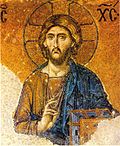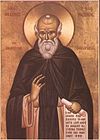- Eastern Orthodox liturgical calendar
-
Part of a series on Eastern Christianity 
History Orthodox Church History
Specific regions:
Byzantine Empire
Ecumenical council
Christianization of Bulgaria
Christianization of Kievan Rus'
East-West Schism
Asian Christianity
Coptic Egypt · UkraineTraditions Orthodox Church
Others:
Oriental Orthodoxy
Ethiopian Tewahedo Church
Coptic Church
Church of the East
Eastern Catholic Churches
Syriac ChristianityLiturgy and worship Sign of the cross
Divine Liturgy
Iconography
Asceticism
OmophorionTheology Hesychasm · Icon
Apophaticism
Filioque clause
Miaphysitism
Monophysitism
Diophysitism
Nestorianism
Theosis · Theoria
Phronema · Philokalia
Praxis · Theotokos
Hypostasis · Ousia
Essence vs. Energies
Metousiosis"Orthodox year" redirects here. For the start of the Hebrew calendar in Orthodox Judaism, see Rosh Hashanah.The Eastern Orthodox liturgical calendar describes and dictates the rhythm of the life of the Eastern Orthodox Church. Associated with each date are passages of Holy Scripture, Saints and events for commemoration, and many times special rules for fasting or feasting that correspond to the day of the week or time of year in relationship to the major feast days.
There are two types of feasts in the Orthodox Church calendar: fixed and movable. Fixed feasts occur on the same calendar day every year, while movable feasts change each year. The moveable feasts are generally relative to Pascha (Easter), and so the cycle of moveable feasts is referred to as the Paschal cycle.
Contents
Fixed feasts
The following list of dates links only to fixed feasts of the Orthodox Church. These are the fixed dates; the particular day on which that date is observed differs depending upon whether one follows the Julian Calendar (sometimes referred to as the "Old Calendar") or the Revised Julian Calendar ("New Calendar"). All dates having to do with Pascha (Easter) - the beginning of Great Lent, Ascension, Pentecost, etc. - are "moveable" feasts, and thus are not on this calendar (see Paschal cycle).
The following should be remembered in using the following calendar:
- For the day in the Gregorian Calendar. on which those churches which follow the Julian Calendar celebrate any date's fixed commemoration, add 13 days to the date below. For example, Christmas Day (December 25) on the Julian Calendar falls on January 7 of the modern Gregorian Calendar.
- For those churches which follow the Revised Julian Calendar the dates below correspond exactly to the dates on the Gregorian Calendar.
The Orthodox liturgical year begins on September 1.
Moveable feasts
Main article: Paschal cyclePascha is, by far, the most important day in the ecclesiastical year, and all other days, in one way or another, are dependent upon it. Pascha falls on different calendar dates from year to year, calculated according to a strict set of rules (see Computus for details). While the Fixed Cycle begins on September 1, the new Paschal Cycle begins on "Zaccheus Sunday" (the beginning of the preparatory season before Great Lent), eleven Sundays before Pascha, and continues until the Zaccheus Sunday of the following year. The Epistle and Gospel readings at the Divine Liturgy throughout the year are determined by the date of Pascha.
Great Feasts
Main article: Great Feasts of the Orthodox ChurchThere are Twelve Great Feasts throughout the church year—not counting Pascha, which is above and beyond all other feast days. These are feasts which celebrate major historical events in the lives of Jesus Christ or the Theotokos (Virgin Mary). Of these, three are on the Paschal Cycle:
- Palm Sunday (the Sunday before Pascha)
- Ascension (forty days after Pascha)
- Pentecost (fifty days after Pascha)
The other Great Feasts are on the Fixed Cycle:
- The Nativity of the Theotokos (8 September)
- The Elevation of the Holy Cross (14 September)
- The Presentation of the Theotokos (21 November)
- The Nativity of the Lord (25 December)
- The Theophany (Epiphany) of the Lord (6 January)
- The Presentation of the Lord (2 February)
- The Annunciation (25 March)
- The Transfiguration (6 August)
- The Dormition (Falling Asleep) of the Theotokos (15 August)
In addition, the feast day of the patron saint of a parish church or monastery is counted as a Great Feast, and is celebrated with great solemnity.
Liturgical seasons
In addition to Great Lent, there are three other lesser lenten seasons in the church year:
- Nativity Fast (40 days in preparation for the Feast of the Nativity of our Lord)
- Apostles' Fast (variable time from the second Monday after Pentecost until the Feast of Saints Peter and Paul)
- Dormition Fast (2 weeks from 1 August to 14 August in preparation for the Feast of the Dormition of the Theotokos)
The season from the Sunday of the Publican and Pharisee (three weeks before the Great Lent) through Holy Saturday is called Triodion, while the season from Pascha through Pentecost is called the Pentecostarion.
Printed calendars
Because of the complexity created by the intersection of the various cycles, a number of Orthodox institutions will print an annual calendar (Russian: Spisok) which contains rubrics for the services during that particular year. Simpler wall calendars will show the major commemoration of the day together with the appointed scripture readings.
References
- For saints, feasts, and other commemorations:
- Orthodox Church Calendar at OrthodoxWiki
- Complete lives of the saints for every day of the Byzantine liturgical year
- Lives of the Saints and Feast days Search at Greek Orthodox Archdiocese of America
- Orthodox Calendar at Holy Trinity Russian Orthodox Church
- Where to learn and purchase Orthodox Liturgical Calendars
- For scriptural readings:
- The Orthodox Study Bible. Nashville, Tennessee: Thomas Nelson Publishers, 1993: 771-780
See also
Calendars of Saints and Commemorations Anglican Communion 
Eastern Orthodox Eastern Orthodox liturgical calendarOriental Orthodox Protestant churches Roman Catholic Current Roman Rite Calendar · Tridentine Calendar · General Roman Calendar of 1954 · General Roman Calendar of 1962Calendars (list) Wide use Selected use Akan · Armenian · Assyrian · Aztec (Tonalpohualli · Xiuhpohualli) · Babylonian · Bahá'í · Bengali · Berber · Bikram Samwat · Buddhist · Bulgar · Burmese · Byzantine · Celtic · Coptic Ethiopian · Hebrew · Hellenic · Hindu (Indian · Malayalam · Tamil) · Igbo · Inca · Iranian (Zoroastrian, Medieval (Jalali), Modern (Hijri)) · Irish · Japanese · Javanese · Juche · Korean · Kurdish · Lithuanian · Maya (Haab' · Tzolk'in) · Minguo · Mongolian · Nanakshahi · Nepal Sambat · Pawukon · Pentecontad · Rapa Nui · Thai (Lunar · Solar) · Tibetan · Vietnamese · Xhosa · Yoruba
Calendar types: Runic · Mesoamerican (Long Count · Calendar round)
Christian variants: Calendar of saints · Eastern Orthodox liturgical calendar · Liturgical year · Revised Julian calendarRarely used Historical Martian Alternative New Age Displays and
applicationsProposed calendars The World Calendar · 13-month calendarYear numbering Fictional Categories:- Eastern Orthodoxy
- Liturgical calendars
- Eastern Christian liturgy
Wikimedia Foundation. 2010.

